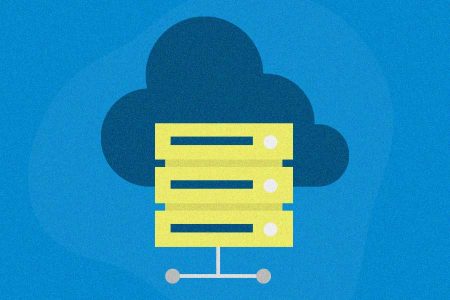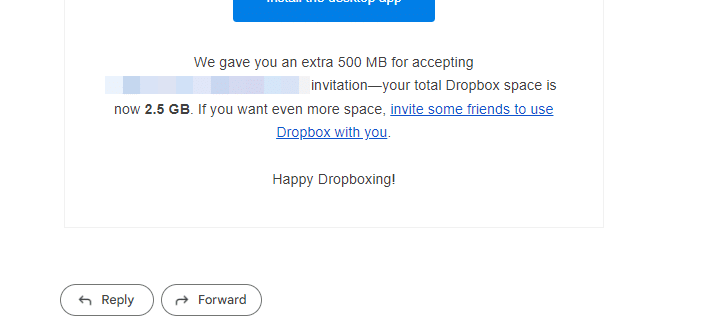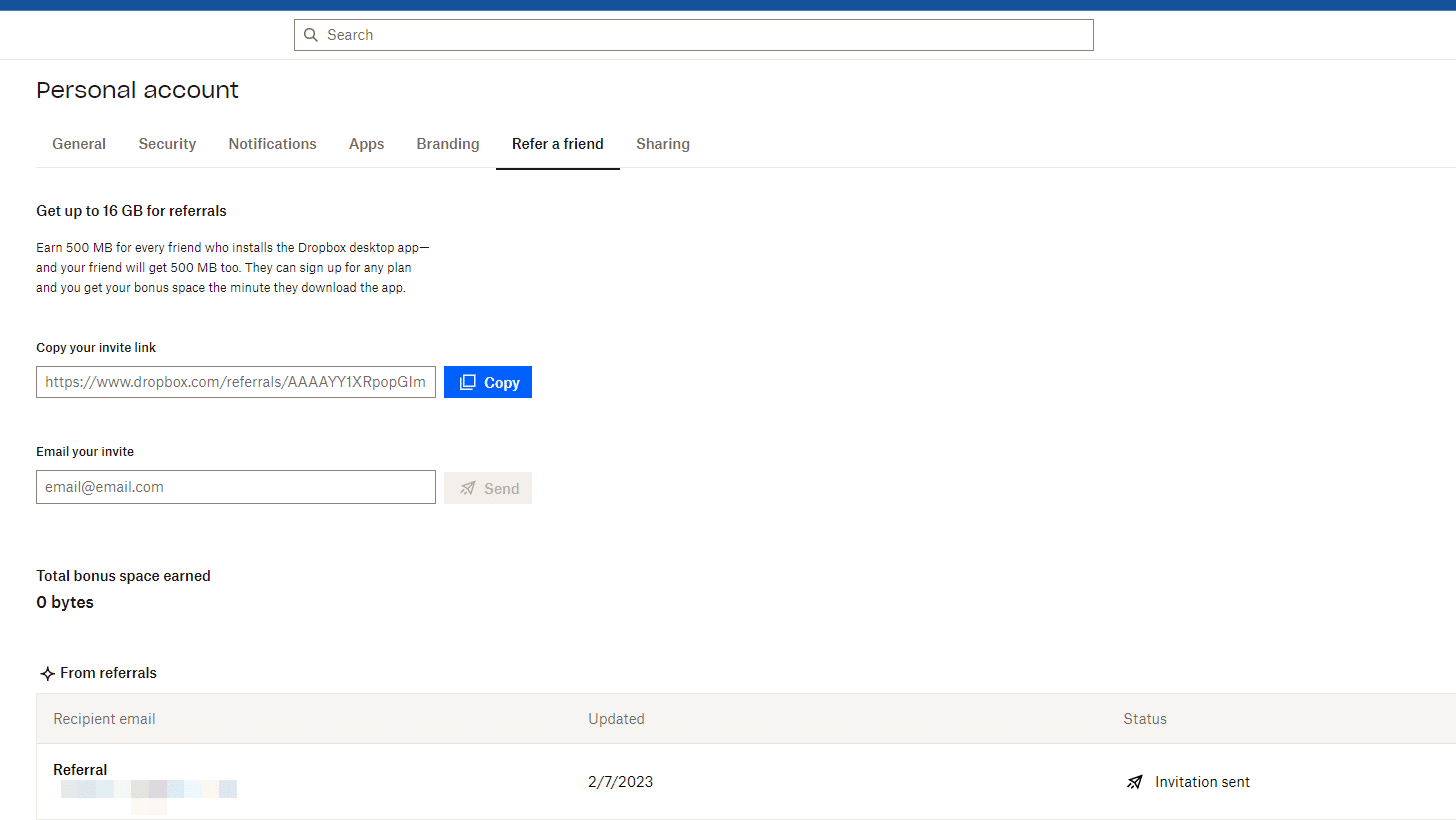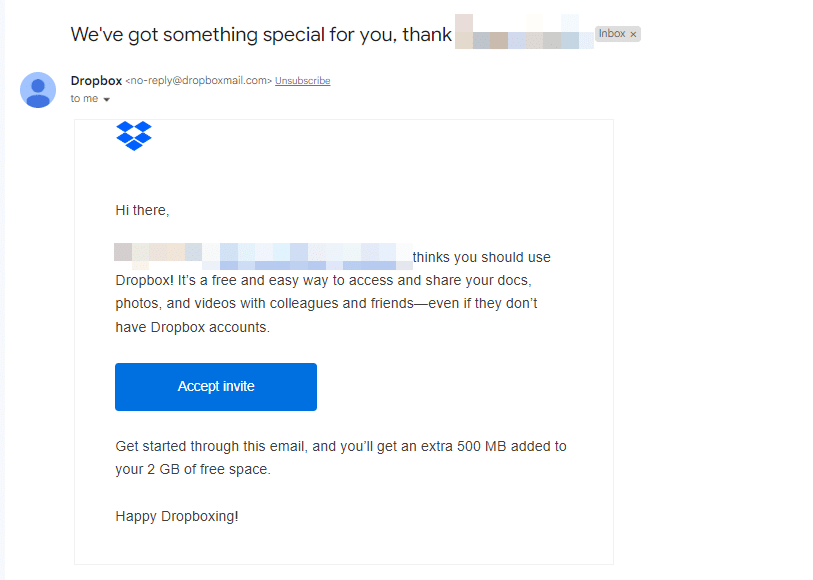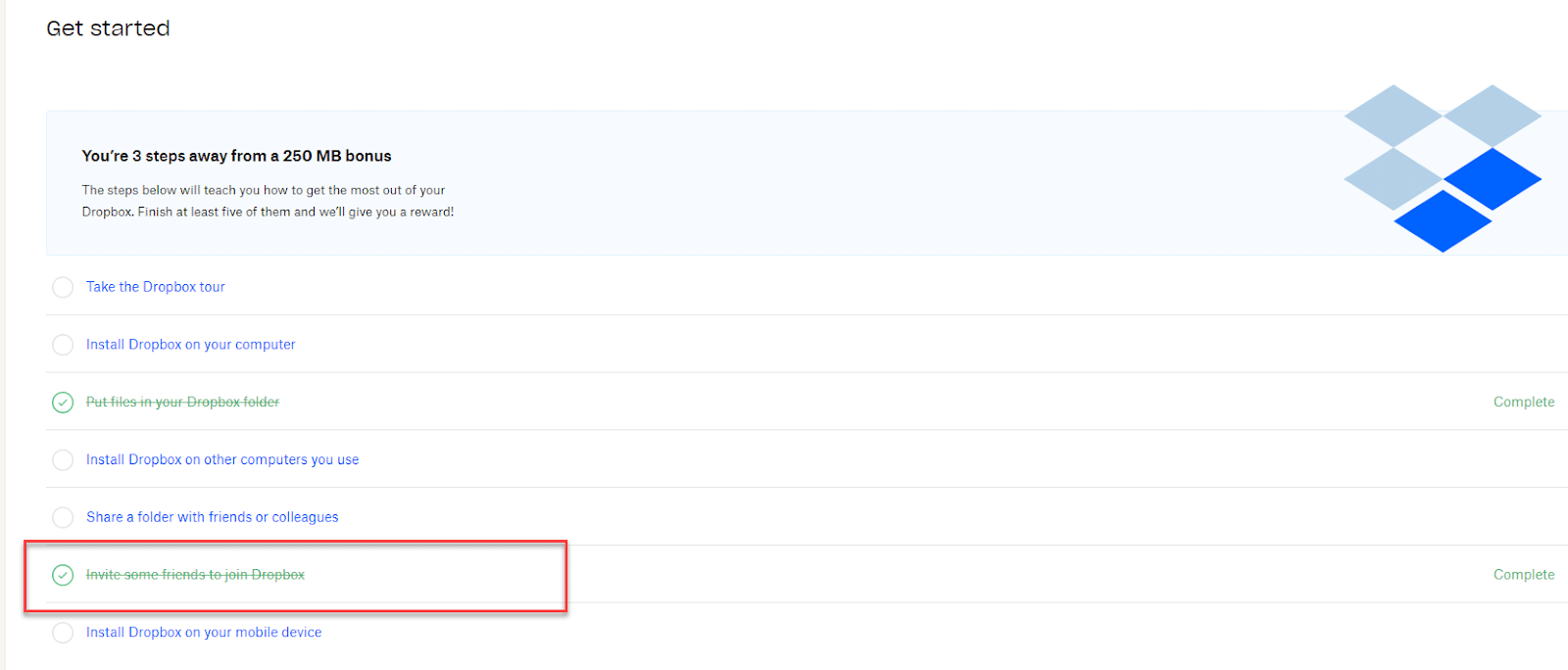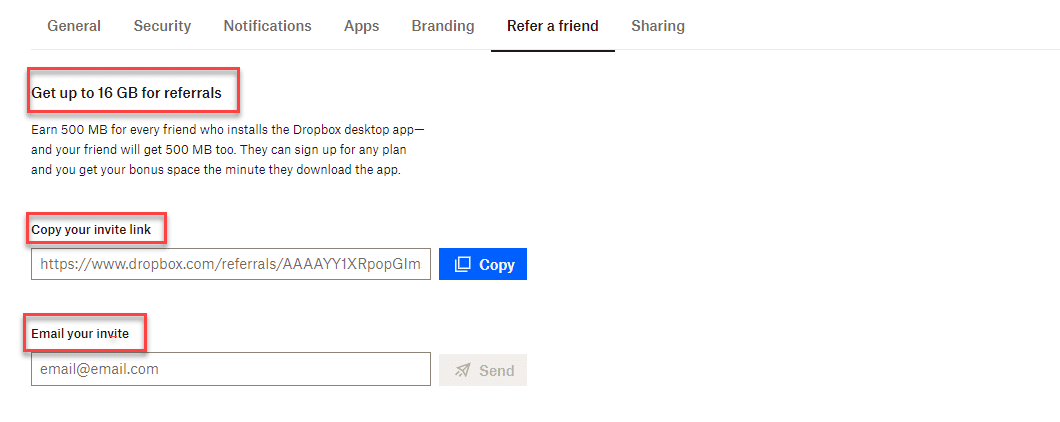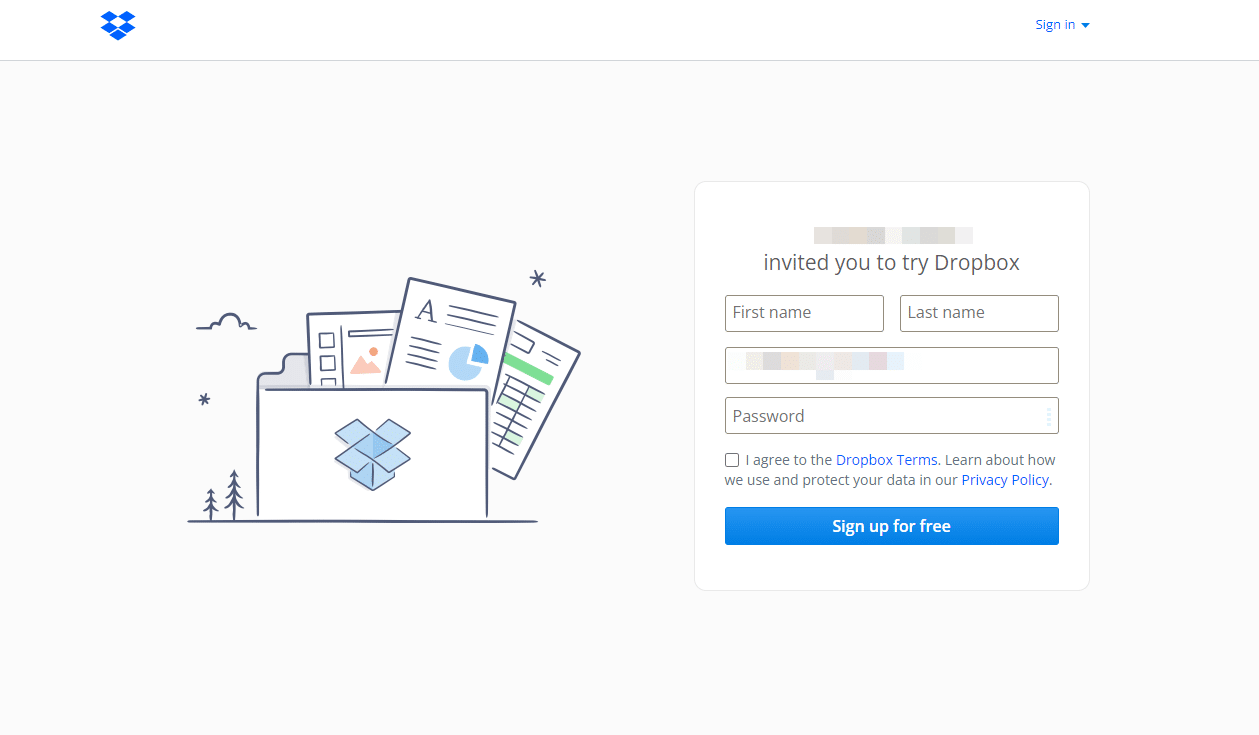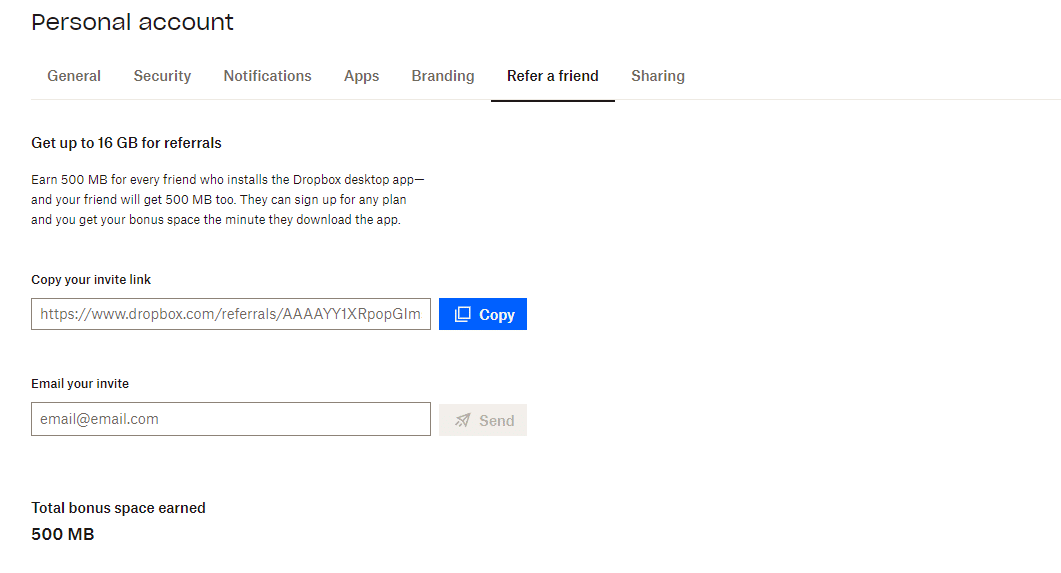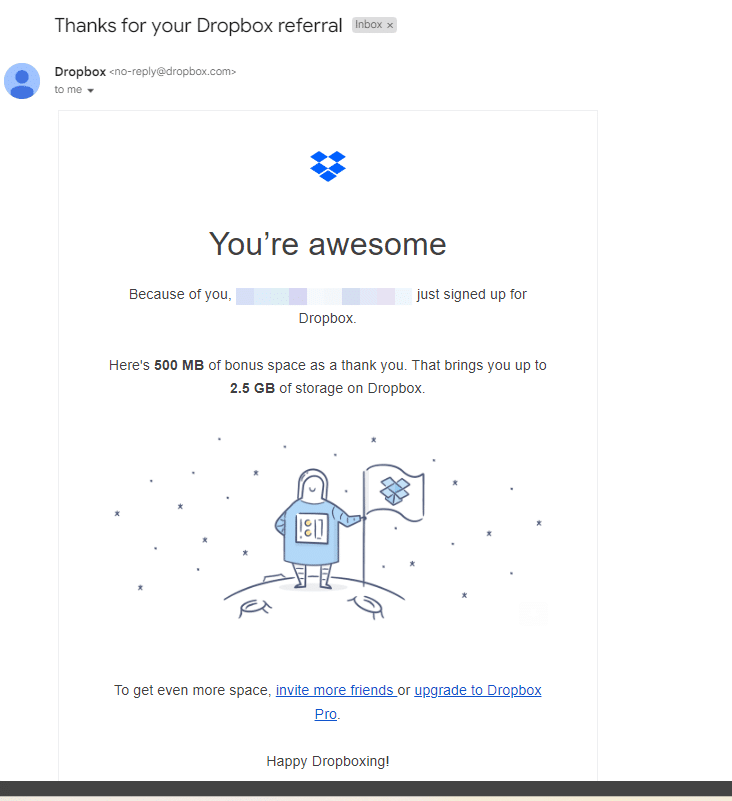Want to find out the secrets of other top-notch referral programs? Check out our other deep dives:
Dropbox is a wildly popular file hosting service that has managed to achieve viral growth. We’re talking super-viral, as in growth of 3900%. But, how did a file service, with stiff competition during its start, actually achieve this? You guessed it – they implemented a referral program.
Because of this program, they were able to grow fast and for practically free. Which is yet another reason why the Dropbox referral program is the most discussed case study in the marketing industry.
Lucky for them, they have a product (cloud storage) that people both want and need. So, with a program that allows users to ‘Get more Space,” they were able to cater to the wants of many users. They really took this opportunity and used it as a stepping stone to grow. In April 2010 alone, their program led to 2.8 million direct referrals from users.
Let’s take a closer look at how the refer a friend Dropbox program continuously managed to get 35% of its daily sign ups from referrals in its first 15 months of launching. We’ve got plenty of ideas for your own referral program that you can take away from this powerhouse referral engine.
Dropbox referral program: How it began
Dropbox is one of the main SaaS contenders when it comes to file hosting and storage. This cloud storage service is well known for letting users sync and back up files between all devices, but it’s also known for its referral program. In fact, it’s one of the biggest success stories in the referral marketing world.
Dropbox was founded in 2007, and they had fierce competition at that time. There were other industry powerhouses like Microsoft that were planning on launching similar products. There were also other similar services that had more capital (at that time) and that had been around longer. So, Dropbox knew that the only way to stay in the game as a startup was to grow faster and bigger than their competition.
Enter the Dropbox referral program. As Dropbox co-founder Drew Houston has shared, the Dropbox referral program drew inspiration from the Paypal viral referral program to help create its own growth engine. Just as PayPal achieved overwhelming success, Dropbox did too. PayPal gave cash as a reward – as they are in the business of money. Dropbox chose to go a similar route and give away their primary product (storage space) as well. And just as PayPal saw referral success, so did Dropbox.
The Dropbox ‘Get More Space” referral program went viral. They literally grew by 3900%, and did this in just 15 months. That’s not just impressive, it’s mind-boggling growth. It’s safe to say their refer-a-friend program was working. And because of this wild growth, they have become a huge game changer when it comes to referral marketing and remain as one of the most talked about programs in the referral industry.
Let’s explore how they came up with their program and what exactly made Dropbox’s referral program so successful.
Referrals: More powerful than paid acquisition
Dropbox did explore other routes to growth. For example, they experimented with paid search ads. However, the paid ads were expensive and didn’t work as well as they hoped. They paid about $233-$338 to acquire a customer, which was well over the product cost and far above budget at the time (proving that this route would not be sustainable or effective in the long run).
During this time, they did a deep dive into their existing user data. They found that about one-third of all of their users already came from word of mouth shared by existing users. This meant they were already tapping into the power of word-of-mouth marketing, and could use that momentum to push their referral program.
At first, they started using referrals simultaneously with the paid search experiment. But, they found referrals to be much more cost efficient and more effective for acquisition. Why? The referrals were nearly free, because Dropbox only “paid” customers in storage space. Because referrals were rapidly coming in, they didn’t need to spend much on traditional ads – they were able to rely on referrals and focus on their program.
The Dropbox referral engine: Driving viral growth
To give you a better understanding of their viral growth, by September 2008, Dropbox had around 100,000 registered users. This in itself was pretty great, considering the stiff competition at the time. However, after implementing their referral program, they jumped up to 2.2 million registered users by September 2009.
Between 2008 and 2010, they actually started doubling their user growth every 3 months. They ended 2010 with around 4 million users, giving them a whopping 3900% growth over the span of 15 months. A big chunk of that is partly due to their 2010 February referrals, where they had 2.8 million referrals come through in that single month!
Fast forward to 2020 – with their referral campaign still going strong, they had 700 million registered users (15.48 million are paying customers). The Dropbox referral program proved to be sustainable and effective, and it continues to drive growth today.
The fact that the program is still active today shows that it continues to help Dropbox sustain growth. It has permanently increased users by 60% – and that increase still holds to this day. It’s safe to say their plan to grow large and fast worked.
How does the Dropbox referral program work?
Dropbox was very clever with how they decided to do their program. They stuck with offering their own product as the reward and chose to promote their program at impactful touchpoints.
How does the company promote the program?
They pick key points, like when a user would be happiest, to promote the program. For example, in the first email a user receives after signing up, they are asked to refer. By doing this, they aim to create a viral effect – where a user refers, their referral joins and is asked to refer, and then the initial user is thanked and nudged again to refer.
What is the referral process?
The referral process is simple. Once a user lands on their referral page, Dropbox has the sharing options displayed, along with reward and referral status information. The process is kept simple, and people are able to invite friends fairly quickly right from the user dashboard.
What rewards are offered and how are they earned?
Dropbox developed their referral program using ideas drawn from the famous PayPal referral program. At the time, PayPal was giving a double-sided $10 reward. For PayPal, this made sense, as they are in the money sharing business. However, that type of reward could easily add up, and it’s been said that PayPal spent close to $70 million on referral rewards. This is something Dropbox simply would not be able to do.
Still, Dropbox kept the approach PayPal took, and focused their program on their core value – storage space. They created a double-sided referral program that awards storage space to both the advocate and friend for a successful referral.
The Dropbox viral loop
Let’s dig even deeper into that viral growth we discussed earlier. Dropbox created a program that utilized a viral loop to continuously drive sharing to get new leads. Both the existing Dropbox user and their referral were ‘in the loop’.
When we say viral loop, we’re referring to when people share a brand with friends, who in turn share with their own friends and so on (in a continuous cycle that feeds itself – a loop). This works really well because it uses the trust of friends to generate new leads from the network you already have. Plus, it’s free or nearly free acquisition.
Notice how Dropbox sends strategic emails to new users who just accepted their friend’s referral invitation. It doesn’t just advertise the extra space their peer gave them, but tells these new users that they can get even more space by inviting their friends.
By doing this, Dropbox encouraged customer acquisition and retention at the same time by investing in their existing network (giving free storage as the reward for referrals). Therefore, the product itself played a huge role in getting the viral loop to take off.
It’s Dropbox’s stellar product, and product-integrated rewards together that drive this continuous loop of sharing.
Why does the loop work?
- It starts with the product: Users refer because they’re impressed with the Dropbox product and how well it works.And they see they can earn more of the product for free.
- The reward (the product) is worth it: Referred friends get storage credits just for signing up through their friend. And if they keep referring, they can get more space on top of that.
- Restarts with the product: Referred friends are impressed with the product and in turn refer more of their own friends. Thus, the cycle continues.
A deep dive into the Dropbox referral program: What made it so successful?
Dropbox really had a lot going for it when they started their referral program. Despite having competition and coming up in a newer space on the web, their platform was well-liked, and already well-discussed. Starting a referral program only fueled the fire they had going.
They planned their program to really help users maximize their use of the product, and that helped not only drive word of mouth, but kept people coming back.
Here are key aspects of the Dropbox referral program that helped make the program a success.
Rewards are tied directly to the user experience
As a cloud storage service, Dropbox sells digital storage space (therefore, space is the product). The more storage space someone has, the better experience they have. Plus, if they have more space, they are more likely to stay as an active user.
With this in mind, Dropbox gives users the opportunity to earn free space, by simply referring. Once the referral signs up, the reward is automatically added to the referring user’s account, and they can be happily on their way.
Users can earn free space with every referral, up through 32 referrals (16GB in total on a Basic Plan and 32GB total on a Plus Plan).
Why does this work?
- The reward is desired. The reward is substantial enough to be motivating. People are using Dropbox as a place to store and share files, so extra space (500 MB for each referral) on this type of platform is something that users want and may need.
- Easy and free for the user. If users want to add more space to their Dropbox account, they see referrals as an option to earn space for free, right below the option to pay to upgrade their account. So, if they aren’t ready to commit to buying, they can grab a little extra storage space for simply getting someone else to sign up.
What strategies can you steal?
Dropbox stayed true to themselves, and kept their bread and butter as the incentive. If you’re able to do so, consider using your product as a reward. Not only will this keep people coming back to you, but if it’s something they already desire, which means it can be quite motivating to get it for free so easily.
Rewards are double-sided
Double-sided rewards are perfect for yielding a higher conversion rate. Because both sides of the referral receive something, they are both more likely to participate in the program. Luckily for Dropbox, they aren’t paying out of pocket for either reward, but are still giving something of value.
Why does the reward work?
- Everyone is happy. Double-sided rewards tend to be very effective because both sides can gain something. In this case, both the referrer and their friend receive a storage space reward.
- They want to keep receiving the reward.This motivates the referrer to keep sharing (and the friend to sign up). If the user needs a little more space down the road, they can refer to keep getting more free space. When the options are to either buy or refer, referring seems like the obvious choice.
- The referred friend likes the offer. It also motivates the friend to start referring their own peers and continue the viral loop.
What strategies can you steal?
A double-sided reward is definitely worth stealing. When both parties get something, the more likely a referral is to convert. But remember, you do not need to always give something tangible. Dropbox offered a little bit of free space – which is both useful and something that their users want.
So if you’re trying to figure out what to reward, think about intangible products or services as well. Does your platform offer a tool, or something special that people would want? If so, maybe think of using it as a driving force for referrals.
Referral program is integrated into the onboarding
Asking for a referral is built into the Dropbox onboarding process. Upon signing up, a user can go through the onboarding process, and as they go through the process they are asked to refer.
The referral is actually included as part of the onboarding process and a task to complete to “become a Dropbox guru.” As you can see, step 6, “Invite some friends to join Dropbox,” is listed as part of the process.
Note: Even if a user does not refer at this point, they know it’s an option they can explore later which is great for all program promotion strategies.
After the onboarding process is complete, Dropbox thanks users and offers more of their product for free – by showing them the program. At this point, users have already entered their information, so they don’t have to enter it again – making referring easy. Plus, at this time, Dropbox is able to reach users when they are actively using the product, so it’s already top of mind.
Why does this work?
- It raises awareness for the program. By touching on the referral program early on, you are making it well-known that a program exists. Program promotion is key – especially if you are newly establishing a referral program.
What strategies can you steal?
If you have an onboarding process or tutorial, try doing a call-out to your referral program. Dropbox slid their program into the onboarding steps, which helps create awareness and trigger a referral to occur.
Simple referral landing page
Anyone can copy the features of Dropbox’s referral page and adapt it for their own program (who wouldn’t? It uses a proven formula).
Upon clicking the ‘refer more friends’ or the ‘refer a friend’ buttons, the referral page pops up. It starts with a reward-forward headline that shows what’s in it for users, then tells what they should do next.
Users can immediately identify they will receive up to 16GB if they copy and share their invite link, or email an invite. By making these pieces of information the focus of this page, they get their point across, and provide an easy way for users to share.
Why does the user’s landing page work?
- It gives insight. It’s super quick, but it provides a clear explanation of how the program works.
- Benefits are front and center. Users can easily see the reward or offer.
- It provides multiple sharing options. Users can send a quick email, and Dropbox does the heavy lifting by sending a prewritten message on the user’s behalf. They also offer the users the option to copy and paste their unique referral link anywhere. In earlier days of the program, they also offered social media sharing options as well.
- Call to actions are evident. The call to action buttons (copy / send) are easy to spot, and users can quickly understand what they need to do.
But Dropbox doesn’t stop there. The landing page that the referred friend sees also follows several best practices.
Why does the referred friend landing page work?
- It provides insight. It reminds the referral who invited them, and what action they should do.
- It’s easy to complete. The page that opens after the referral clicks the link shared by their friend is very short and sweet. The form to fill out is minimal, and that makes it easier to persuade a referral to complete the desired action.
- There is an evident CTA. The button is bright and big, and tells the referral exactly what they need to do.
What strategies can you steal?
In both cases, the existing user and their referred friend will land on these pages by clicking just one link. By making this process easy and short, they are making it easier for people to participate. A lot of times when multiple steps are involved, people tend to jump ship.
On top of that, both pages are simple, but get the point across. They provide a strong headline, and explain what action needs to be done.
For the referrals who click on the shared link, you can notice how the email field of the signup form is already prefilled. This little touch makes the process of signing up even quicker (which makes it even more inviting).
Referral dashboard
The Dropbox referral dashboard lets users track the status of every referral, so a user always knows when referrals are successful (keeping users in the loop is vital!). It’s also where users can refer from or copy their link to share.
Dropbox, again, kept it simple. They give a little insight to the program.They offer a couple of sharing options, and they give status information. All of these combined make participation in the program convenient, and easy.
Why does this dashboard work?
- It tracks referral status. Dropbox allows users to track the status of each referral sent. Oftentimes a dashboard will allow users to see if their friend signed up, installed, verified their email, or fully completed the signup process.
- It shows rewards earned. It also shows when rewards are earned (and how much bonus space was earned in total). That can also act as a motivator to earn more rewards.
What strategies can you steal?
People like to be kept in the loop. By providing insight on where their referrals are, users can get a better understanding of what to expect. Plus, if a friend hasn’t opened the email and it’s been a while, the user may reach out to them or send another referral.
You should also consider showing the rewards available and rewards earned. Dropbox shows how much space out of the total space allowed to earn is available. It’s a nice insight for the user and may keep them motivated to keep referring to reach that final number.
Strategic emails to create repeat advocates
Everytime a referral signs up, the user is thanked via email. This thank you message is vital in allowing Dropbox to show its appreciation. This helps the user feel good, and this feel-good moment can also be a great opportunity to ask for more referrals.
Why does this email work?
- It gives a status update. Emails notify a user right when their friend signs up, and it also covers reward status.
- It’s visually appealing. Dropbox uses an eye-catching “made it to the moon” image. This doesn’t clutter the page, but it does make the page visually appealing.
- It shows appreciation. “You’re awesome” and “Because of you” are great little thank yous that help the user feel appreciated.
- It’s a great opportunity to ask again. The text at the bottom says “To get even more space, invite more friends.” This encourages a user to keep referring at a time when they’re on a natural high from getting the reward.
What strategies can you steal?
If you are going to thank someone for a referral, use this as an opportunity to fill two needs with one deed. Dropbox used their thank you email as a way to promote their program again. This small tweak to a thank you email drives users to make multiple referrals.
What to keep in mind for your own program?
Dropbox found a referral formula that worked really well for them. There are plenty of aspects from their program that any business can utilize.
But, in order to prevent any pitfalls, here are a few things to ask yourself.
- Is my product worth it? You’ll have to make sure your product or service is worth referring before you start a program. Dropbox’s program is successful because the product is the entire foundation of the program.
- How will I run the referral program? You may consider building a referral program from scratch. However, using a referral software like Referral Rock is the easiest way to set up a referral program like Dropbox’s, and track its success.
- Referral software can automate many aspects of your program. For example, you would not have to spend time sending rewards. It could all happen automatically, allowing you to keep your customers or subscribers happy.
- You’ll have built in safeguards to prevent fraudulent referrals. We’d all like to think we wouldn’t need this. But, users may try self referring as a way to get more rewards. This is especially the case when the product is free.
- How will I share referral progress? Dropbox keeps users in the loop with the status of each referral. If you want to run a program where customers can access a dashboard and track their referral progress, you’ll have to keep in mind that not all referral software has the capability to do this. Referral Rock does and lets you set up a referral dashboard with ease.
- Who will receive a reward if we give one? As Dropbox does, it’s best to reward both the referrer and new customer when the new customer makes their first purchase (or signs up). This is one of the best ways to create a viral loop. And potentially encourage multiple referrals from the same customer.
- How fast do I want to grow? Your company likely won’t have a program that is as viral as the Dropbox program, but referral programs are still an effective way to drive customer acquisition and retention. Going viral should not be the expectation when considering options to drive customer acquisition. But, virality is always great when it does happen.
Conclusion
Dropbox offers one of the most well-known and successful referral programs out there. Their massive growth was partly due to their referral program. It was the combination of having a product people not only wanted but also may have needed, and using that product as an integral part of their referral program. Their 3900% in growth did happen pretty quickly, but again people really liked their platform.
Because of this, they were able to drive word of mouth. By giving their users the option to buy more space, or refer for more space – Dropbox was able to make their referral program that much more effective.
Inspired and ready for more referral program ideas and tips? We’ve got you covered.
